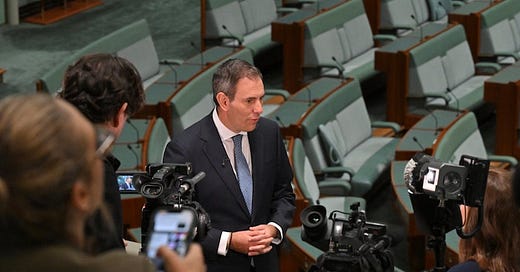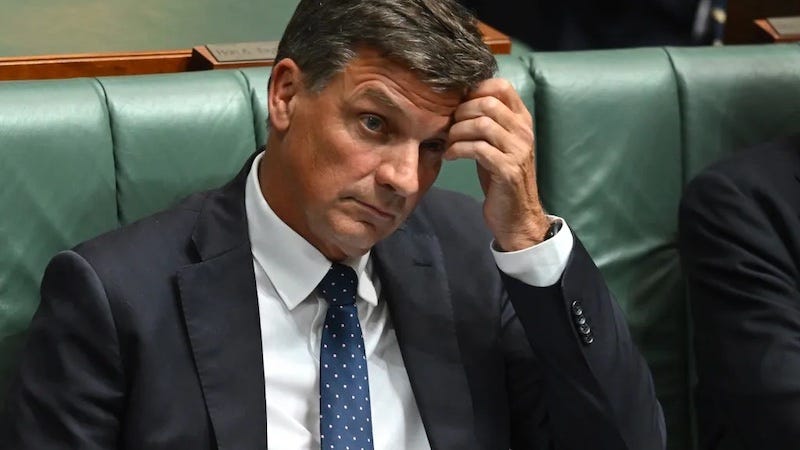The Budget myth: How spin, amnesia and outrage skew the debate
The most radical act in this entire Budget process might be the first tiny step of putting people first, not last.
As Australia edges closer to the federal Budget announcement, the political atmosphere feels subdued and unusually calm – too calm for a nation whose media and political class is addicted to economic alarmism every single day of the week. But beneath the surface, the old ideological machinery is grinding into gear, preparing to unleash the same tired narratives: deficits are disasters, surpluses are sacrosanct, and the only measure of economic competence is whether the Budget is in the black or red. It’s as though the Australian media, in lockstep with conservative politicians, is gearing up to recycle the same well-worn clichés – one that barely survives a moment of honest scrutiny.
The prevailing narrative is clear: when Labor runs a deficit – which is expected this week – it is cast as the end of the economic world, if the not the world itself, a fiscal apocalypse borne of incompetence, recklessness, and spendthrift ideologies. However, when Labor delivers a surplus, it’s brushed off as dumb luck, timing, or the favourable result of external forces well beyond their control. Conversely, when a Coalition government runs deficits – and they’ve run quite a few – it’s always attributed to unfortunate circumstances, international headwinds, or inherited problems. And when they scrape together a surplus? It’s trumpeted as the product of prudent, responsible, adult economic management, regardless of the reality.
Over the last two years, Treasurer Jim Chalmers has quietly delivered two consecutive budget surpluses – an achievement not seen in almost two decades. He’s now signaling a return to deficit in the upcoming budget, but the context matters: it’s a manageable deficit, designed to address neglected public services, essential recovery programs, and inflationary pressures without tipping the economy into stagnation. Yet this nuance is lost in the mainstream coverage, which is already gearing up for doomsday headlines, as if Australia were hurtling toward hyperinflation or a debt spiral worthy of a banana republic.
This predictable hysteria is not just economically incoherent, it’s journalistically lazy. It thrives on the financial illiteracy of much of the media commentariat – many of whom parrot phrases like “back in black” or “budget black hole” with no understanding of how macroeconomics, sovereign currency systems, or public investment work in practice. In this alternative universe, a deficit is treated as a moral failing rather than a fiscal tool, and budget policy is assessed through the lens of household accounting analogies that have no business being applied to national economies. It’s economic populism dressed in the language of prudence, and it’s designed to serve a political agenda, not the public good.
Chalmers is not above criticism – far from it – but compared to his recent predecessors, he appears at least grounded in reality. He’s resisted the temptation to turn fiscal policy into a weapon of ideology. Instead, he’s focused on stabilising the Budget, reducing the structural deficit left behind by the Coalition, and targeting spending where it’s needed: disaster recovery, healthcare, infrastructure, and the education sector, which has been starved of reform and funding for years. He’s also juggling the enormous financial weight of the AUKUS submarine deal – a geopolitical indulgence cloaked as somehow a strategic necessity, draining public funds that could otherwise transform domestic policy settings.
But this isn’t the conversation the electorate is being offered. Instead, the national discourse is being hijacked by scare campaigns and superficial talking points. Deficits aren’t inherently bad. In fact, in times of global economic uncertainty, they’re often necessary: the Menzies government ran large budget deficits between 1958–59 and 1966–67, much larger than any deficits in the modern era, and very few commentators complained at the time. What matters is what the money is spent on, and whether it improves national capacity, social equity, and long-term prosperity. But these questions rarely get asked on morning TV panels or in tabloid headlines. It’s all about the debt.
The coming Budget will almost certainly provoke a tidal wave of outrage from conservative commentators and Coalition politicians – claims of reckless spending, irresponsible governance, and impending fiscal catastrophe. But Australians have lived through nearly a decade of Coalition Budgets marked by increasing inequality, underinvestment in essential services, and economic stagnation. They remember the real outcomes, not just the slogans. And for all the criticism Chalmers will receive in the coming days, what he’s actually doing is something the political system hasn’t seen in a while: using economic policy to try to help people.
It’s still nowhere near enough but that, in itself, might be the most radical act in this entire Budget process: putting people first, not last.
The Budget as pure political theatre
Budgets in Australia have increasingly become stage-managed political performances designed to control the media cycle for a brief moment before vanishing into the fog of public disinterest. For all the theatre, most Budgets are lucky to command a full day’s attention. The Budget reply delivered by the Opposition Leader two nights later is even more marginalised – often broadcast during late-night shopping or up against Thursday night sport, and lost to a nation more interested in starting to think about their weekend than digesting political financial details. This short attention span has only emboldened governments of all stripes to rely on drip-feed announcements in the lead-up, deploying a scattershot strategy of selective funding reveals weeks in advance, long before the Budget itself is formally tabled.
This year, we’ve already seen announcements on boosted Medicare funding – Labor’s ideological heartland – a push toward universal access to early education and childcare, support for metal and steel industries, state-targeted infrastructure spending, and funding for public education in NSW. These announcements blur into one another, lacking distinction or memorability, and often appear recycled from earlier press conferences. It becomes difficult to tell whether they are new initiatives, re-packaged promises, or just politically expedient reminders of previous commitments. This confusion isn’t a flaw in the strategy – it is the strategy, perfected by the previous Morrison government.
The Budget itself won’t necessarily introduce bold new policies or radical fiscal directions. Instead, it will act as a giant ledger, pulling together months of disparate funding measures and policy intentions into a coherent framework that can be marketed as proof of responsible governance. The message will be simple: Labor has delivered targeted investments in health, education, infrastructure, and industry without blowing out the Budget or fuelling inflation. There will be a deliberate contrast between these measures and the memory of a chaotic, ad-hoc Coalition era, where announcements were made for political convenience and often left unfunded or unrealised – again, a strategy perfected by Scott Morrison.
In an election year, every line item of the Budget becomes both a signal and a shield – signalling to the public the values and priorities of the government, while shielding it from anticipated attacks on economic management. The Coalition will attempt to revive its tired trope of Labor’s fiscal irresponsibility, but it’s likely to fall flat in the face of Labor’s recent track record – two surpluses, falling interest payments, a shrinking deficit, and visible improvements to essential services. In contrast, the Coalition has not yet presented a convincing economic alternative, beyond slogans and structural opposition to public investment.
But the issue here is that the entire Budget process has become an act of political choreography rather than genuine policymaking. When the budget is treated as a public relations opportunity rather than a serious moment of economic direction-setting, the conversation stays stuck in public image, not impact. This is especially troubling given the underlying issues that continue to plague the nation: a sluggish housing market and unaffordable rents, underemployment, stagnant wages, a still-strained health system, and an education sector – including early education – which is overdue for major structural reform. A few billion dollars here or there won’t be enough to reverse decades of systemic neglect, and there remains the lingering concern that even well-intentioned spending can be overtaken by the demands of political pragmatism.
This kind of budgeting is less about vision and more about legacy. The Albanese government isn’t aiming for just the headlines; it’s aiming for permanence – of course, a government is always going to be interested in getting re-elected and remaining in office, but it has to keep sight of why it wants to remain it office and how it can best work towards the public interest.
Fantasy figures and economic gaslighting: The Coalition’s lies won’t be enough
Desperate to frame the Albanese government as fiscally irresponsible and economically destructive, the Liberal Party, through its Shadow Treasurer Angus Taylor, has started throwing around the exaggerated tax claims that are designed to provoke rather than to inform. But these claims aren’t just politically cynical – they’re transparently false, economically incoherent, and increasingly at odds with the lived reality of most Australians.
Taylor’s headline-grabbing assertion that every Australian is paying “$3,500 more in tax” since 2021 – conveniently, the last year of Coalition government – isn’t just misleading; it’s untraceable. There’s no source, no calculation and no context, just a vague allusion to the Parliamentary Budget Office, without any of the analytical rigour or transparency one would expect from a Shadow Treasurer, and calibrated to sound just plausible enough to enrage the disengaged, while being vague enough to avoid immediate fact-checking by casual listeners.
But in today’s media environment, such laziness is reckless. If the figure were somehow based around increased tax receipts, it would reflect rising incomes, stronger employment, and consumer activity – all indicators of a healthier economy. If it’s based on the GST, then it’s a function of more consumer spending, not government greed. Australians pay more GST when they spend more – and if they’re spending more, they’re generally earning more. If Taylor’s data source was the tax-to-GDP ratio (which has increased), it still doesn’t support his narrative. That ratio is well within historical norms, and under Coalition governments, it’s often been higher. In other words, whatever metric he’s chosen – if any – it’s either good economic news or bad analysis, and in this case, probably both.
The Coalition’s economic messaging has become a case study in political gaslighting. Taylor and his colleagues aren’t attempting to engage with policy or macroeconomic reality, they’re simply counting on voters to feel financially squeezed and then offering up a scapegoat – taxes – without any honest exploration of cause or context. But unlike the shock-jock era of political messaging, this kind of shallow economics doesn’t hold up anymore. Australians are more economically literate than the political class gives them credit for, and while they might not glean through the reams of Budget papers, they certainly know the difference between personal experience and political bluster. If their pay slips haven’t changed in the way Taylor claims, they’re not going to swallow his talking points just because he yells them out louder.
This is the central political problem the Coalition faces: the narrative dissonance. Political leaders can’t keep insisting that the economy is on fire when millions of Australians are quietly noticing that – while far from it being perfect – the economic picture is not as dire as the Coalition claims. Households may be feeling the pinch from inflation and interest rates, but they can also see that the government has made serious investments in Medicare, early childhood education, and infrastructure. They’ve watched as a $78 billion deficit has been reduced, and they understand that patching up a decade of Coalition neglect takes more than slogans and soundbites.
In this climate, trying to scare people into voting against their own experience and their own interests is a political dead-end. It’s no longer enough to weaponise deficits or throw around meaningless tax claims. The modern electorate demands specificity, realism, and – above all – honesty, and this is not something Taylor appears capable of delivering. His faux theatre might play well in press conferences or right-wing radio circles, but for a voter standing at the checkout or opening up their payslip, it’s a hollow message.
Politics isn’t just about who shouts the loudest: it’s about whose version of reality people choose to believe. Right now, the Coalition is offering nothing more than a caricature of economic collapse, held together by dubious statistics and assumptions about voter ignorance. If they want to be taken seriously, they’ll have to start offering something real. Until then, their economic critiques will remain exactly what they appear to be: made-up numbers, shouted into the void.












Dutton only has half-baked immigration nonsense, while Taylor is denying reality. They are unfit to govern.
Well said. Excellent journalism.